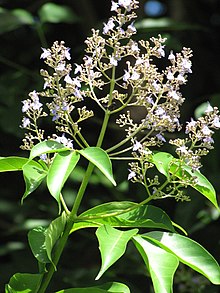Vitex parviflora
| Vitex parviflora | |
|---|---|

| |
| Scientific classification | |
| Kingdom: | Plantae |
| Clade: | Tracheophytes |
| Clade: | Angiosperms |
| Clade: | Eudicots |
| Clade: | Asterids |
| Order: | Lamiales |
| Family: | Lamiaceae |
| Genus: | Vitex |
| Species: | V. parviflora
|
| Binomial name | |
| Vitex parviflora | |
Vitex parviflora[2] is a species of plant in the family Verbenaceae, also known as smallflower chastetree[3] or the molave tree. It is found in Indonesia, Malaysia, and the Philippines. It is threatened by habitat loss. The name "molave" is from Spanish, derived from Tagalog mulawin. It is also known as tugas in Visayan languages.[4]
It yields one of two woods from the same genus called molave wood, the other being Vitex cofassus. It is valued in the Philippines for its dense durable wood, and was once used extensively in furniture, boats, utensils, and as construction material. However, due to overharvesting and habitat loss, it is now classified as endangered by the Philippine Department of Environment and Natural Resources.[5][6]
References[]
- ^ de Kok, R. (2020). "Vitex parviflora". IUCN Red List of Threatened Species. 2020: e.T33339A67741355. doi:10.2305/IUCN.UK.2020-1.RLTS.T33339A67741355.en. Retrieved 15 November 2021.
- ^ "Molave". OneToTree. Retrieved 2021-12-03.
- ^ USDA, NRCS (n.d.). "Vitex parviflora". The PLANTS Database (plants.usda.gov). Greensboro, North Carolina: National Plant Data Team. Retrieved 6 August 2015.
- ^ Bareja, Ben G. "Two Strains of Molave Tree Distinguished". Cropsreview.com. Retrieved 14 August 2017.
- ^ "Molave". The Return of the Philippine Native Trees. Rain Forest Restoration Initiative. Retrieved 14 August 2017.
- ^ Bareja, Ben G. "The Molave Trees are Amazing, What With Their Plenty of Conventional Uses and New Ones That Evolved". Cropsreview.com. Retrieved 14 August 2017.
Categories:
- IUCN Red List least concern species
- Vitex
- Trees of Malesia
- Vulnerable plants
- Lamiaceae stubs
